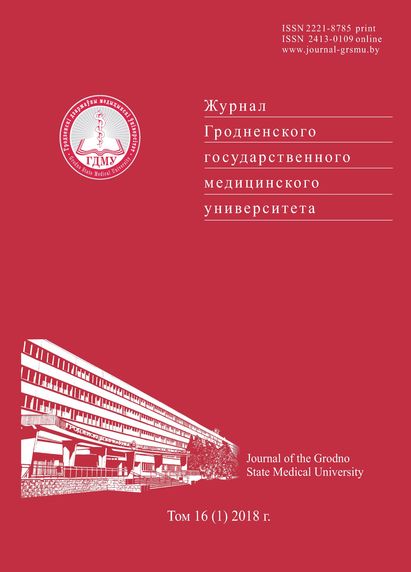КЛИНИЧЕСКАЯ МОРФОЛОГИЯ ПЕЧЕНИ: ЗЛОКАЧЕСТВЕННЫЕ ОПУХОЛИ
Аннотация
Введение. Среди очаговых поражений печени более точный учет имеет место только при злокачественных опухолях печени (ЗОП). По данным ВОЗ, ЗОП являются пятыми по частоте формами рака у мужчин и седьмыми – у женщин, занимая третье место среди причин смерти от злокачественных новообразований в мире.
Цель – представить морфологическую характеристику ЗОП, диагностируемых в Гродненском регионе.
Материал и методы. Объектом исследования были биоптаты печени, полученные путем проведения аспирационной биопсии печени у пациентов с подозрением на опухолевый процесс, фрагменты печени, иссеченные при оперативном вмешательстве, а также секционный материал.
Результаты. Представлена Международная классификация ЗОП. Согласно классификации приведено описание наиболее часто диагностируемых ЗОП в Гродненском регионе. Представлены примеры (фотографии) основных представителей ЗОП: первичных и вторичных, эпителиального и мезенхимального происхождения. Более подробно дана характеристика гепатоцеллюлярного и холангиоцеллюлярного рака печени. Указаны морфологические признаки опухолей, необходимые при проведении дифференциальной диагностики.
Выводы. Качественная диагностика ЗОП, отличающихся значительным разнообразием, возможна при осуществлении комплексного морфологического исследования, проведенного опытными специалистами методами гистологического, иммуногистохимического, нередко ультраструктурного анализа. Знание структурных особенностей ЗОП будет способствовать повышению роли ультразвуковой и лучевой диагностики на ранних стадиях ЗОП.
Литература
Serov VV, Lapish K, Sekamova S, Beketova TP; USSR Academy of Medical Sciences Morfologicheskaja diagnostika zabolevanij pecheni [Morphological diagnosis of liver diseases]. Moscow: Meditsina, 1989. 336 p. (Russian).
Algoritmy diagnostiki i lechenija zlokachestvennyh novoobrazovanij. Klinicheskie protokoly [Algorithms for diagnosis and treatment of malignant neoplasms. Clinical protocols]. Onkologicheskij zhurnal [Oncological journal]. 2013;7(1):6-506. (Russian).
WHO. WHO histological classification of tumors of the liver and intraheatic bile ducts. 2000. Chap. 8, Tumours of the Liver and Intrahepatic Bile Ducts; p. 153-202. https://www.iarc.fr/en/publications/pdfs-online/pat-gen/ bb2/bb2-chap8.pdf.
Nordenstedt H, White DL, El-Serag HB. The changing pattern of epidemiology in hepatocellular carcinoma. Digestive and Liver Disease. 2010;42(3):206-214. doi: 10.1016/S1590-8658(10)60507-5.
Shchegolev AI, Tinkova IO, Mishnev OD. Klassifikacija i morfologicheskaja harakteristika opuholej pecheni: zlokachestvennye jepitelialnye opuholi: (lekcija) [Classification and Morphological Description of Liver Tumors: Malignant Epithelial Tumors: (lecture)]. Meditsinskaya vizualizatsiya [Medical Visualization]. 2005;4:11-26. (Russian).
Suh SW, Choi YS. Predictors of Micrometastases in Patients with Barcelona Clinic Liver Cancer Classification B Hepatocellular Carcinoma. Yonsei Medical Journal. 2017;58(4):737-742. doi: 10.3349/ymj.2017.58.4.737.
Okeanov AE, Moiseyev PI, Evmenenko AA, Alexandrov NN; National Cancer Centre of Belarus; Sukonko OG, ed. 25 let protiv raka. Uspehi i problemy protivorakovoj borby v Belarusi za 1990-2014 gody [25 years contrary cancer. The successes and challenges of cancer control in Belarus for the years 1990-2014]. Minsk: Republican Scientific Medical Library; 2016. 415 p. URL: http://rep. med.by/handle/data/127. (Russian).
Tumors of the hepatobiliary system. In: Fletcher CDM, ed. Diagnostic Histopathology of Tumors. 2th ed. Vol. 1. Edinburg [etc.]: Churchill Livingstone; 2000. p. 411-460.
Horie Y, Shigoku A, Tanaka H, Tomie Y, Maeda N, Hoshino U, Koda M, Shiota G, Yamamoto T, Kato S, Murawaki Y, Suou T, Kawasaki H. Prognosis for pedunculated hepatocellular carcinoma. Oncology. 1999;57(1):23-28.
International Working Party. Terminology of nodular hepatocellular lesions. Hepatology. 1995;22(3):983-993.
Chacko S, Samanta S. Hepatocellular carcinoma. Biomedicine & Pharmacotherapy. 2016;84:1679-1688. doi: 10.1016/j.biopha.2016.10.078.
Haddock RL, Paulino YC, Bordallo R. Viral hepatitis and liver cancer on the Island of Guam. Asian Pacific Journal of Cancer Prevention. 2013;14(5):3175-3180.
Kim BN, Park JW. Epidemiology of liver cancer in South Korea. Clinical and Molecular Hepatology. 2017. doi: 10.3350/cmh.2017.0112.
Craig JR, Peters RL, Edmondson HA, Omata M. Fibrolamellar carcinoma of the liver: a tumor of ado lescents and young adults with distinctive clinicopatholog is features. Cancer. 1980;46(2):72-379. doi: 10.1002/1097-0142(19800715) 46:2<372::AIDCNCR2820460227>3.0.CO;2-S.
Baithun SI, Pollock DJ. Oncocytic hepatocellular tumor. Histopathology. 1983;7(1):107-112.
Hammond WJ, Lalazar G, Saltsman JA, Farber BA, Danzer E, Sherpa TC, Banda CD, Andolina JR, Karimi S, Brennan CW, Torbenson MS, La Quaglia MP, Simon SM. Intracranial metastasis in fibrolamellar hepatocellular carcinoma. Pediatric Blood & Cancer. 2017. doi: 10.1002/pbc.26919.
Edmondson HA, Steiner PE. Primary carcinoma of the liver: a study of 100 cases among 48,900 necropsies. Cancer. 1954;7(3):462-503.
Maeda T, Adachi E, Kajiyama K, Takenaka K, Sugimachi K, Tsuneyoshi M. Spindle cell hepatocellular carcinoma: a clinicopathologic and immunohistochemical analysis of 15 cases. Cancer. 1996;77:51-57.
Carriaga MT, Henson DE. Liver, gallbladder, extrahepatic bile ducts, and pancreas. Cancer. 1995;75(1):171-190.
Saunders WV. Blumgart’s Surgery of the Liver, Biliary Tract and Pancreas. 3rd еd. London, 2000. Chap. 51, Blumgart LH, Fong Y. Surgery of the liver and biliary tract; p. 953.
Ding G, Yang Y, Cao L, Chen W, Wu Z, Jiang G. A modified Jarnagin-Blumgart classification better predicts survival for resectable hilar cholangiocarcinoma. World Journal of Surgical Oncology. 2015;13:99. doi: 10.1186/s12957-015-0526-5.
Sasaki A, Aramaki M, Kawano K, Morii Y, Nakashima K, Yoshida T, Kitano S. Intrahepatic peripheral cholangiocarcinoma: mode of spread and choice of surgical treatment. British Journal of Surgery. 1998;85(9):1206-1209.
Ikai I, Itai Y, Okita K, Omata M, Kojiro M, Kobayashi K, Nakanuma Y, Futagawa S, Makuuchi M, Yamaoka Y. Report of the 15th follow-up survey of primary liver cancer. Hepatology Research. 2004;28(1):21-29. URL: https://doi.org/10.1016/j.hepres.2003. 08.002.
Higginson J, Steiner PE. Definition and classification of malignant epithelial neoplasms of the liver. Acta: Unio Int ernationalis Contra Cancrum. 1961;17:593-603.
Devaney K, Goodman ZD, Ishak KG. Hepatobiliary cystadenoma and cystadenocarcinoma. A light microscopic and immunohistochemical study of 70 patients. The American journal of surgical pathology. 1994;18(11):1078-1091.
Moore S, Gold RP, Lebwohl O, Price JB, Lefkowitch JH. Adenosquamous carcinoma of the liver arising in biliary cystadenocarcinoma: clinical, radiologic, and pathologic features with review of the literature. Journal of Clinical Gastroenterology. 1984;6(3):267-275.
Unger PD, Thung SN, Kaneko M. Pseudosarcomatous cystadenocarcinoma of the liver. Human Pathology. 1987;18(5):521-523.
Wolf HK, Garcia JA, Bossen EH. Oncocytic differentiation intrahepatic biliary cystadenocarcinoma. Modern Pathology. 1992;5(6):665-668.
Allen RA, Lisa JR. Combined liver cell and bile duct carcinoma. American Journal of Pathology. 1949:25(2):647-655.
Fisher HP, Doppl W, Osborn M, Altmannsberger M. Evidence for a hepatocellular lineage in a combined hepatocellularcholangiocarcinoma of transitional type. Virchows Archiv. B, Cell pathology including molecular pathology. 1988;56(2):71-76.
Shabanov MA. Gistogenez i klassifikacija pervichnyh opuholej pecheni u detej [Histogenesis and classification of primary liver tumors in children]. Arhiv patologii [Archive of Pathology]. 1983;45(5):55-60. (Russian).
Stocker J, Conran R, Selby D. Tumor and pseudotumors of the liver. In: Stocker J, Askin F, eds. Pathology of solid tumors in children. London: Chapman & Hall; 1998. p. 83-110.
Sugino K, Dohi K, Matsuyama T, Asahara T, Yamamoto M. A case of hepatoblastoma occurring in an adult. The Japanese journal of surgery. 1989;19(4):489-493.
Balduzzi C, Yantorno M, Mosca I, Apraiz M, Velázquez MJ, Puente MC, Moragrega V, Ligorría R, Ottino A, Belloni R, Barbero R, Jmelniztky A, Chopita N. Primary hepatic lymphoma: an infrequent cause of focal hepatic lesion. Acta Gastroenterológica Latinoamericana. 2010;40(4):361-366.





























